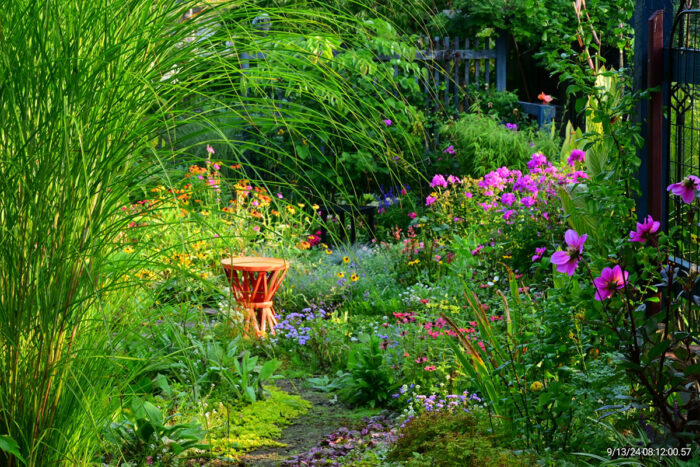
Hi GPODers!
Today we’re returning to the always beautiful garden of Tingshu Hu in Dunstable, Massachusetts. We’ve seen her garden through the seasons (Spring: Flowering Trees in Tingshu’s Garden, summer: Summer in Tingshu’s Front Garden and Back Garden, and fall: Tingshu’s Massachusetts Garden), and most recently saw her transform a dead patch of her lawn into a low-maintenance oasis (Tingshu’s Low Maintenance Garden in Massachusetts). Now we will be seeing all of the incredible plants and pairings that shine in her garden during the transitional period of late summer. Today is a focus on her back gardens and tomorrow we will back to tour the front garden, which will include an update on that incredible low-maintenance space she showed off earlier this year.

 Another focal point in the back garden is the fish pond. One yellow lotus (Nelumbo lutea, Zones 4–11) is blooming in the pond. Another lotus with pink flower grows in a pot beside a pergola. There are many gold fish and bull frogs in the pond. A snake regularly visits the pond. Around the fish pond are low growing and low maintenance ground covers. A few annuals, Sallyfun™ Deep Ocean salvia (Salvia farinacea ‘Deep Ocean’, annual), floss flower (Ageratum houstonianum, annual) and zinnia, added long lasting colors. The yellow and orange flowers on the right side are black-eyed Susan and rudbeckia. A Japanese maple and a redtwig dogwood are on the back (north) side of the pond. Between them is a tall garden phlox with pink flowers.
Another focal point in the back garden is the fish pond. One yellow lotus (Nelumbo lutea, Zones 4–11) is blooming in the pond. Another lotus with pink flower grows in a pot beside a pergola. There are many gold fish and bull frogs in the pond. A snake regularly visits the pond. Around the fish pond are low growing and low maintenance ground covers. A few annuals, Sallyfun™ Deep Ocean salvia (Salvia farinacea ‘Deep Ocean’, annual), floss flower (Ageratum houstonianum, annual) and zinnia, added long lasting colors. The yellow and orange flowers on the right side are black-eyed Susan and rudbeckia. A Japanese maple and a redtwig dogwood are on the back (north) side of the pond. Between them is a tall garden phlox with pink flowers.

 Looking toward the fish pond from the west side. A dahlia plant with dark purple leaves and pink flowers stands on the north side of the patio. Beside it are hummingbird mint, salvia, red-hot porker with yellow flowers.
Looking toward the fish pond from the west side. A dahlia plant with dark purple leaves and pink flowers stands on the north side of the patio. Beside it are hummingbird mint, salvia, red-hot porker with yellow flowers.






What a vibrant, yet lush and relaxing setting as the days get shorter and cooler! Be sure to check back tomorrow to see Tingshu’s equally inviting front garden.
Have a garden you’d like to share?
Have photos to share? We’d love to see your garden, a particular collection of plants you love, or a wonderful garden you had the chance to visit!
To submit, send 5-10 photos to gpod@taunton.com along with some information about the plants in the pictures and where you took the photos. We’d love to hear where you are located, how long you’ve been gardening, successes you are proud of, failures you learned from, hopes for the future, favorite plants, or funny stories from your garden.
Have a mobile phone? Tag your photos on Facebook, Instagram or Twitter with #FineGardening!
Do you receive the GPOD by email yet? Sign up here.
Fine Gardening Recommended Products

ARS Telescoping Long Reach Pruner
Fine Gardening receives a commission for items purchased through links on this site, including Amazon Associates and other affiliate advertising programs.

Dramm Revolution Adjustable 9-Pattern Metal Hose Nozzle
Fine Gardening receives a commission for items purchased through links on this site, including Amazon Associates and other affiliate advertising programs.
- Ergonomic insulated grip
- Maximum pressure of 90 PSI
- Fully adjustable spray pattern
- No trigger lock



















Comments
Packed with beauty!
Thanks for your appreciation!
You took the words right out of my mouth! LOL!
Fabulous garden - so full of color!
Your encouragement is much appreciated!
Barberry (Berberis) is on the Massachusetts invasive list. It can not be bought, sold, or given away. It is destroying the woodlands as birds are depositing the berberis berries which grow into bushes which out perform our native plants as berberis doesn't have natural predators to keep it in check. You should remove it to save our environment.
Thanks from your comments. We planted the barberry before it was banned from trading. We have been looking for a better replacement.
sometimes one of the purple cotinus ,if kept pruned down, can sub for a berberis.
it is my understanding that colored berberis are not invasive like green berberis. we have had aurea, helmond's pillar, atropurpurea and other purples, incl. concorde, for 35 yrs in our gardens , and have never seen seedlings in our gardens, or those of neighbors.
re: invasives and other official sanctions, we have not just blindly followed the rules, but have sought more info and the advise of trusted nursery and botanical garden people. Gov't related bodies ,because they are writing for the norm, don't have time to deal w/exceptions, when so often, exceptions exist. but maybe you have found differently.......
arboretum...I almost missed your comment and I want to thank you for the information you've shared! I totally agree with you.
An amazing accomplishment- A well designed garden- so full of so many beautiful plants that all look nice together as you have them arranged,.
I like your barberry and I see no logical reason to destroy or remove it. They were banned in my state of Pennsylvania as well, and I all my years as a gardener I have never seen them reproducing seedlings or growing wild taking over nature.
A little known fact: Monsanto was one of the companies involved in setting up the National Invasive Species Council
Here is an excerpt from an interview with Tao Orion:
K: A lot of people have heard the term, “invasive species” and most of them of course are assuming it’s something bad, but when it comes right down to it, it’s actually very difficult to define the term and we could even say that there isn’t one definition of that term.
T: Yes, that’s something that I found really interesting as I was researching my book, because I was really trying to find out if there was a clear, objective description of what an invasive species is, and I found that even the National Invasive Species Council—which in the US is the federal government level board that looks at invasive species issues—spent years on deliberating on the definition and even so, they weren’t able to come up with something that I felt was purely an objective description that could be [applied] in all contexts. It seemed to vary from place to place and time to time.
K: Monsanto was one of the companies involved in setting [that council] up.
T: That’s another disturbing element about how the big frenzy around invasive species and the purported damage that they do came to be so popular; a lot of that was informed and funded by pesticide interests to spur the sale of products, herbicides in particular, to deal with species invasions.
Source link https://milliontrees.me/2022/03/15/beyond-the-war-on-invasive-species-interview-with-tao-orion/
Thank you so much, Sue, for looking this up! Wow, Monsanto was involved in setting up the council to sale their products! Indeed, I never saw seedlings of barberry around the garden except for some under the plant. I never saw birds eating the seeds since they prefer much tastier crabapple berries.
Thank you Sue, you have saved my Barberry. It has been there for many years, greeting me everyday, like an old friend.
You are very welcome Tingshu99
Log in or create an account to post a comment.
Sign up Log in